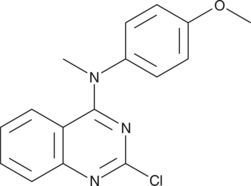Chemicals
Showing 27601–27750 of 41137 results
-
Monotropein is an iridoid glycoside originally isolated from M. officinalis roots and has diverse biological activities.{46362,46363,46364,46365,46366} It increases cell viability and migration of bone marrow-derived endothelial progenitor cells (BM-EPCs) when used at concentrations ranging from 0.1 to 1,000 μM.{46362} Monotropein inhibits apoptosis and reduces levels of matrix metalloproteinase-3 (MMP-3) and MMP-13 in chondrocytes.{46363} It inhibits LPS-induced nuclear translocation of NF-κB and reduces COX-2, inducible nitric oxide synthase (iNOS), TNF-α, and IL-1β mRNA expression in RAW 264.7 cells.{46364} Monotropein (100 and 200 mg/kg) reduces colonic myeloperoxidase (MPO) activity, COX-2 and iNOS mRNA expression, and disease severity in a mouse model of ulcerative colitis induced by dextran sulfate sodium (DSS; Item No. 23250). It increases bone mineral content, bone mineral density, and improves bone microstructure in ovariectomized mice when administered at doses of 40 or 80 mg/kg.{46365} Monotropein (20 and 30 mg/kg) reduces acetic acid-induced writhing in mice and carrageenan-induced paw edema in rats.{46366} It also decreases macrophage infiltration and wound healing time and increases blood vessel formation in a rat model of wound healing.{46362}
Brand:CaymanSKU:27595 - 10 mgAvailable on backorder
Monotropein is an iridoid glycoside originally isolated from M. officinalis roots and has diverse biological activities.{46362,46363,46364,46365,46366} It increases cell viability and migration of bone marrow-derived endothelial progenitor cells (BM-EPCs) when used at concentrations ranging from 0.1 to 1,000 μM.{46362} Monotropein inhibits apoptosis and reduces levels of matrix metalloproteinase-3 (MMP-3) and MMP-13 in chondrocytes.{46363} It inhibits LPS-induced nuclear translocation of NF-κB and reduces COX-2, inducible nitric oxide synthase (iNOS), TNF-α, and IL-1β mRNA expression in RAW 264.7 cells.{46364} Monotropein (100 and 200 mg/kg) reduces colonic myeloperoxidase (MPO) activity, COX-2 and iNOS mRNA expression, and disease severity in a mouse model of ulcerative colitis induced by dextran sulfate sodium (DSS; Item No. 23250). It increases bone mineral content, bone mineral density, and improves bone microstructure in ovariectomized mice when administered at doses of 40 or 80 mg/kg.{46365} Monotropein (20 and 30 mg/kg) reduces acetic acid-induced writhing in mice and carrageenan-induced paw edema in rats.{46366} It also decreases macrophage infiltration and wound healing time and increases blood vessel formation in a rat model of wound healing.{46362}
Brand:CaymanSKU:27595 - 25 mgAvailable on backorder
Monotropein is an iridoid glycoside originally isolated from M. officinalis roots and has diverse biological activities.{46362,46363,46364,46365,46366} It increases cell viability and migration of bone marrow-derived endothelial progenitor cells (BM-EPCs) when used at concentrations ranging from 0.1 to 1,000 μM.{46362} Monotropein inhibits apoptosis and reduces levels of matrix metalloproteinase-3 (MMP-3) and MMP-13 in chondrocytes.{46363} It inhibits LPS-induced nuclear translocation of NF-κB and reduces COX-2, inducible nitric oxide synthase (iNOS), TNF-α, and IL-1β mRNA expression in RAW 264.7 cells.{46364} Monotropein (100 and 200 mg/kg) reduces colonic myeloperoxidase (MPO) activity, COX-2 and iNOS mRNA expression, and disease severity in a mouse model of ulcerative colitis induced by dextran sulfate sodium (DSS; Item No. 23250). It increases bone mineral content, bone mineral density, and improves bone microstructure in ovariectomized mice when administered at doses of 40 or 80 mg/kg.{46365} Monotropein (20 and 30 mg/kg) reduces acetic acid-induced writhing in mice and carrageenan-induced paw edema in rats.{46366} It also decreases macrophage infiltration and wound healing time and increases blood vessel formation in a rat model of wound healing.{46362}
Brand:CaymanSKU:27595 - 5 mgAvailable on backorder
Monotropein is an iridoid glycoside originally isolated from M. officinalis roots and has diverse biological activities.{46362,46363,46364,46365,46366} It increases cell viability and migration of bone marrow-derived endothelial progenitor cells (BM-EPCs) when used at concentrations ranging from 0.1 to 1,000 μM.{46362} Monotropein inhibits apoptosis and reduces levels of matrix metalloproteinase-3 (MMP-3) and MMP-13 in chondrocytes.{46363} It inhibits LPS-induced nuclear translocation of NF-κB and reduces COX-2, inducible nitric oxide synthase (iNOS), TNF-α, and IL-1β mRNA expression in RAW 264.7 cells.{46364} Monotropein (100 and 200 mg/kg) reduces colonic myeloperoxidase (MPO) activity, COX-2 and iNOS mRNA expression, and disease severity in a mouse model of ulcerative colitis induced by dextran sulfate sodium (DSS; Item No. 23250). It increases bone mineral content, bone mineral density, and improves bone microstructure in ovariectomized mice when administered at doses of 40 or 80 mg/kg.{46365} Monotropein (20 and 30 mg/kg) reduces acetic acid-induced writhing in mice and carrageenan-induced paw edema in rats.{46366} It also decreases macrophage infiltration and wound healing time and increases blood vessel formation in a rat model of wound healing.{46362}
Brand:CaymanSKU:27595 - 50 mgAvailable on backorder
Montelukast is a cysteinyl leukotriene 1 (CysLT1) receptor antagonist (IC50 = 4.9 nM in HEK293 cell membranes expressing the human receptor).{14081} It is selective for CysLT1 over CysLT2 receptors (IC50 = >10,000 nM in COS-7 cell membranes expressing the human receptor).{8519} Montelukast inhibits bronchoconstriction induced by leukotriene D4 (LTD4; Item No. 20310) in anesthetized guinea pigs (ED50 = 69 nmol/kg, p.o.).{10911} It inhibits ovalbumin-induced airway hyperresponsiveness and increases in the number of total cells and eosinophils in bronchoalveolar lavage fluid (BALF) in a mouse model of allergic asthma when administered at doses of 3 and 10 mg/kg.{11231} Formulations containing montelukast have been used in the treatment of asthma, allergic rhinitis, and exercise-induced bronchoconstriction.
Brand:CaymanSKU:10008318 - 10 mgAvailable on backorder
Montelukast is a cysteinyl leukotriene 1 (CysLT1) receptor antagonist (IC50 = 4.9 nM in HEK293 cell membranes expressing the human receptor).{14081} It is selective for CysLT1 over CysLT2 receptors (IC50 = >10,000 nM in COS-7 cell membranes expressing the human receptor).{8519} Montelukast inhibits bronchoconstriction induced by leukotriene D4 (LTD4; Item No. 20310) in anesthetized guinea pigs (ED50 = 69 nmol/kg, p.o.).{10911} It inhibits ovalbumin-induced airway hyperresponsiveness and increases in the number of total cells and eosinophils in bronchoalveolar lavage fluid (BALF) in a mouse model of allergic asthma when administered at doses of 3 and 10 mg/kg.{11231} Formulations containing montelukast have been used in the treatment of asthma, allergic rhinitis, and exercise-induced bronchoconstriction.
Brand:CaymanSKU:10008318 - 100 mgAvailable on backorder
Montelukast is a cysteinyl leukotriene 1 (CysLT1) receptor antagonist (IC50 = 4.9 nM in HEK293 cell membranes expressing the human receptor).{14081} It is selective for CysLT1 over CysLT2 receptors (IC50 = >10,000 nM in COS-7 cell membranes expressing the human receptor).{8519} Montelukast inhibits bronchoconstriction induced by leukotriene D4 (LTD4; Item No. 20310) in anesthetized guinea pigs (ED50 = 69 nmol/kg, p.o.).{10911} It inhibits ovalbumin-induced airway hyperresponsiveness and increases in the number of total cells and eosinophils in bronchoalveolar lavage fluid (BALF) in a mouse model of allergic asthma when administered at doses of 3 and 10 mg/kg.{11231} Formulations containing montelukast have been used in the treatment of asthma, allergic rhinitis, and exercise-induced bronchoconstriction.
Brand:CaymanSKU:10008318 - 50 mgAvailable on backorder
Montelukast is a cysteinyl leukotriene 1 (CysLT1) receptor antagonist (IC50 = 4.9 nM in HEK293 cell membranes expressing the human receptor).{14081} It is selective for CysLT1 over CysLT2 receptors (IC50 = >10,000 nM in COS-7 cell membranes expressing the human receptor).{8519} Montelukast inhibits bronchoconstriction induced by leukotriene D4 (LTD4; Item No. 20310) in anesthetized guinea pigs (ED50 = 69 nmol/kg, p.o.).{10911} It inhibits ovalbumin-induced airway hyperresponsiveness and increases in the number of total cells and eosinophils in bronchoalveolar lavage fluid (BALF) in a mouse model of allergic asthma when administered at doses of 3 and 10 mg/kg.{11231} Formulations containing montelukast have been used in the treatment of asthma, allergic rhinitis, and exercise-induced bronchoconstriction.
Brand:CaymanSKU:10008318 - 500 mgAvailable on backorder
Morantel is a positive allosteric modulator of neuronal nicotinic acetylcholine receptors (nAChRs).{39211} It enhances channel gating of the α3β2 nAChR subtype by binding to non-canonical sites.{39210} Formulations containing morantel are used to treat nematode infections in livestock.{39209}
Brand:CaymanSKU:22902 - 1 gAvailable on backorder
Morantel is a positive allosteric modulator of neuronal nicotinic acetylcholine receptors (nAChRs).{39211} It enhances channel gating of the α3β2 nAChR subtype by binding to non-canonical sites.{39210} Formulations containing morantel are used to treat nematode infections in livestock.{39209}
Brand:CaymanSKU:22902 - 100 mgAvailable on backorder
Morantel is a positive allosteric modulator of neuronal nicotinic acetylcholine receptors (nAChRs).{39211} It enhances channel gating of the α3β2 nAChR subtype by binding to non-canonical sites.{39210} Formulations containing morantel are used to treat nematode infections in livestock.{39209}
Brand:CaymanSKU:22902 - 250 mgAvailable on backorder
Moroxydine is a heterocyclic biguanidine compound with antiviral activity. In grass carp reovirus-infected CIK cells, virus-related Bcl-2- and caspase-mediated apoptosis is reduced by 50% following treatment with 6.3 µg/ml of moroxydine for 96 hours.{34665} Moroxydine targets DNA and RNA viruses including measles, herpes simplex, varicella zoster, and hepatitis C, and formulations containing moroxydine are used to treat the symptoms of influenza virus strain A infection.{34665,34663,34662} Moroxydine is considered effective and generally safe in veterinary applications. In gibel carp housed at 25°C, the absorption and elimination half-lives are 2.02 and 4.22 hours, respectively, following oral administration of a 10 mg/kg dose of moroxydine.{34664}
Brand:CaymanSKU:21647 -Out of stock
Moroxydine is a heterocyclic biguanidine compound with antiviral activity. In grass carp reovirus-infected CIK cells, virus-related Bcl-2- and caspase-mediated apoptosis is reduced by 50% following treatment with 6.3 µg/ml of moroxydine for 96 hours.{34665} Moroxydine targets DNA and RNA viruses including measles, herpes simplex, varicella zoster, and hepatitis C, and formulations containing moroxydine are used to treat the symptoms of influenza virus strain A infection.{34665,34663,34662} Moroxydine is considered effective and generally safe in veterinary applications. In gibel carp housed at 25°C, the absorption and elimination half-lives are 2.02 and 4.22 hours, respectively, following oral administration of a 10 mg/kg dose of moroxydine.{34664}
Brand:CaymanSKU:21647 -Out of stock
Moroxydine is a heterocyclic biguanidine compound with antiviral activity. In grass carp reovirus-infected CIK cells, virus-related Bcl-2- and caspase-mediated apoptosis is reduced by 50% following treatment with 6.3 µg/ml of moroxydine for 96 hours.{34665} Moroxydine targets DNA and RNA viruses including measles, herpes simplex, varicella zoster, and hepatitis C, and formulations containing moroxydine are used to treat the symptoms of influenza virus strain A infection.{34665,34663,34662} Moroxydine is considered effective and generally safe in veterinary applications. In gibel carp housed at 25°C, the absorption and elimination half-lives are 2.02 and 4.22 hours, respectively, following oral administration of a 10 mg/kg dose of moroxydine.{34664}
Brand:CaymanSKU:21647 -Out of stock
Morroniside is an iridoid glucoside that has been found in L. chrysatha.{52846} This product is a mixture of 7α-morroniside and 7β-morroniside.
Brand:CaymanSKU:30711 - 10 mgAvailable on backorder
Morroniside is an iridoid glucoside that has been found in L. chrysatha.{52846} This product is a mixture of 7α-morroniside and 7β-morroniside.
Brand:CaymanSKU:30711 - 100 mgAvailable on backorder
Morroniside is an iridoid glucoside that has been found in L. chrysatha.{52846} This product is a mixture of 7α-morroniside and 7β-morroniside.
Brand:CaymanSKU:30711 - 5 mgAvailable on backorder
Morroniside is an iridoid glucoside that has been found in L. chrysatha.{52846} This product is a mixture of 7α-morroniside and 7β-morroniside.
Brand:CaymanSKU:30711 - 50 mgAvailable on backorder
Morusin is a prenylated flavonoid that has been found in M. alba and has diverse biological activities, including enzyme inhibitory, anti-inflammatory, and antiproliferative properties.{52095,52094,52093,59092} It inhibits the UDP-glucuronosyltransferase (UGT) isoforms UGT1A6, UGT1A7, and UGT1A8 (IC50s = 4.23, 0.98, and 3 μM, respectively) and the cytochrome P450 (CYP) isoforms CYP3A4, CYP1A2, CYP2C9, and CYP2E1 (IC50s = 2.13, 1.27, 3.18, and 9.28 μM, respectively).{52095} Morusin (4 μM) inhibits histamine and leukotriene C4 (LTC4) production induced by A23187 (Item No. 11016) and phorbol 12-myristate 13-acetate (PMA; Item No. 10008014) in mouse MC/9 mast cells.{52094} It also inhibits the growth of MCF-7, MDA‑MB‑231, and MDA‑MB‑453 breast cancer cells (IC50s = 13.53, 10.84, and 11.99 μM, respectively).{52093} Morusin (12.5 mg/kg per day) decreases colonic tissue damage, TGF-β1 levels, and matrix metalloproteinase-2 (MMP-2) and MMP-9 activity in a rat model of TNBS-induced ulcerative colitis.{59092}
Brand:CaymanSKU:28857 - 10 mgAvailable on backorder
Morusin is a prenylated flavonoid that has been found in M. alba and has diverse biological activities, including enzyme inhibitory, anti-inflammatory, and antiproliferative properties.{52095,52094,52093,59092} It inhibits the UDP-glucuronosyltransferase (UGT) isoforms UGT1A6, UGT1A7, and UGT1A8 (IC50s = 4.23, 0.98, and 3 μM, respectively) and the cytochrome P450 (CYP) isoforms CYP3A4, CYP1A2, CYP2C9, and CYP2E1 (IC50s = 2.13, 1.27, 3.18, and 9.28 μM, respectively).{52095} Morusin (4 μM) inhibits histamine and leukotriene C4 (LTC4) production induced by A23187 (Item No. 11016) and phorbol 12-myristate 13-acetate (PMA; Item No. 10008014) in mouse MC/9 mast cells.{52094} It also inhibits the growth of MCF-7, MDA‑MB‑231, and MDA‑MB‑453 breast cancer cells (IC50s = 13.53, 10.84, and 11.99 μM, respectively).{52093} Morusin (12.5 mg/kg per day) decreases colonic tissue damage, TGF-β1 levels, and matrix metalloproteinase-2 (MMP-2) and MMP-9 activity in a rat model of TNBS-induced ulcerative colitis.{59092}
Brand:CaymanSKU:28857 - 5 mgAvailable on backorder
Morusin is a prenylated flavonoid that has been found in M. alba and has diverse biological activities, including enzyme inhibitory, anti-inflammatory, and antiproliferative properties.{52095,52094,52093,59092} It inhibits the UDP-glucuronosyltransferase (UGT) isoforms UGT1A6, UGT1A7, and UGT1A8 (IC50s = 4.23, 0.98, and 3 μM, respectively) and the cytochrome P450 (CYP) isoforms CYP3A4, CYP1A2, CYP2C9, and CYP2E1 (IC50s = 2.13, 1.27, 3.18, and 9.28 μM, respectively).{52095} Morusin (4 μM) inhibits histamine and leukotriene C4 (LTC4) production induced by A23187 (Item No. 11016) and phorbol 12-myristate 13-acetate (PMA; Item No. 10008014) in mouse MC/9 mast cells.{52094} It also inhibits the growth of MCF-7, MDA‑MB‑231, and MDA‑MB‑453 breast cancer cells (IC50s = 13.53, 10.84, and 11.99 μM, respectively).{52093} Morusin (12.5 mg/kg per day) decreases colonic tissue damage, TGF-β1 levels, and matrix metalloproteinase-2 (MMP-2) and MMP-9 activity in a rat model of TNBS-induced ulcerative colitis.{59092}
Brand:CaymanSKU:28857 - 50 mgAvailable on backorder
Mosapride is an agonist of the serotonin (5-HT) receptor subtype 5-HT4 (Ki = 69.9 nM).{52440,30682} It is selective for 5-HT4 over 5-HT1, 5-HT2, dopamine D2, and α1- and α2-adrenergic receptors but acts as a partial antagonist at 5-HT3 (Ki = 1,189 nM).{52440,30682} It induces relaxation of precontracted rat esophageal thoracic muscularis mucosa preparations and enhances electrically evoked contractions in isolated guinea pig ileum (EC50s = 208.4 and 73.2 nM, respectively).{39019} Mosapride (0.5 and 1 mg/kg, i.v.) increases antral and duodenal, but not ileal or colonic, motility in conscious dogs.{52440} It also increases gastric emptying in rats when administered at doses ranging from 0.03 to 30 mg/kg.
Brand:CaymanSKU:30048 - 10 mgAvailable on backorder
Mosapride is an agonist of the serotonin (5-HT) receptor subtype 5-HT4 (Ki = 69.9 nM).{52440,30682} It is selective for 5-HT4 over 5-HT1, 5-HT2, dopamine D2, and α1- and α2-adrenergic receptors but acts as a partial antagonist at 5-HT3 (Ki = 1,189 nM).{52440,30682} It induces relaxation of precontracted rat esophageal thoracic muscularis mucosa preparations and enhances electrically evoked contractions in isolated guinea pig ileum (EC50s = 208.4 and 73.2 nM, respectively).{39019} Mosapride (0.5 and 1 mg/kg, i.v.) increases antral and duodenal, but not ileal or colonic, motility in conscious dogs.{52440} It also increases gastric emptying in rats when administered at doses ranging from 0.03 to 30 mg/kg.
Brand:CaymanSKU:30048 - 100 mgAvailable on backorder
Mosapride is an agonist of the serotonin (5-HT) receptor subtype 5-HT4 (Ki = 69.9 nM).{52440,30682} It is selective for 5-HT4 over 5-HT1, 5-HT2, dopamine D2, and α1- and α2-adrenergic receptors but acts as a partial antagonist at 5-HT3 (Ki = 1,189 nM).{52440,30682} It induces relaxation of precontracted rat esophageal thoracic muscularis mucosa preparations and enhances electrically evoked contractions in isolated guinea pig ileum (EC50s = 208.4 and 73.2 nM, respectively).{39019} Mosapride (0.5 and 1 mg/kg, i.v.) increases antral and duodenal, but not ileal or colonic, motility in conscious dogs.{52440} It also increases gastric emptying in rats when administered at doses ranging from 0.03 to 30 mg/kg.
Brand:CaymanSKU:30048 - 250 mgAvailable on backorder
Mosapride is an agonist of the serotonin (5-HT) receptor subtype 5-HT4 (Ki = 69.9 nM).{52440,30682} It is selective for 5-HT4 over 5-HT1, 5-HT2, dopamine D2, and α1- and α2-adrenergic receptors but acts as a partial antagonist at 5-HT3 (Ki = 1,189 nM).{52440,30682} It induces relaxation of precontracted rat esophageal thoracic muscularis mucosa preparations and enhances electrically evoked contractions in isolated guinea pig ileum (EC50s = 208.4 and 73.2 nM, respectively).{39019} Mosapride (0.5 and 1 mg/kg, i.v.) increases antral and duodenal, but not ileal or colonic, motility in conscious dogs.{52440} It also increases gastric emptying in rats when administered at doses ranging from 0.03 to 30 mg/kg.
Brand:CaymanSKU:30048 - 50 mgAvailable on backorder
Motilin is a polypeptide hormone that stimulates gastric motility through release in the small intestine and into the general circulation during fasting.{33844} In isolated rabbit duodenal segments, porcine motilin (10 nM-1 µM) induced phasic contractions and acetylcholine release from enteric neurons (EC50 = 2.5 nM).{33804} Formulations containing motilin are used to increase gastrointestinal motility in patients with diabetic gastroparesis, often in combination with erythromycin (Item No. 17191), an antibiotic and agonist at the motilin receptor.{33844}
Brand:CaymanSKU:21619 -Out of stock
Motilin is a polypeptide hormone that stimulates gastric motility through release in the small intestine and into the general circulation during fasting.{33844} In isolated rabbit duodenal segments, porcine motilin (10 nM-1 µM) induced phasic contractions and acetylcholine release from enteric neurons (EC50 = 2.5 nM).{33804} Formulations containing motilin are used to increase gastrointestinal motility in patients with diabetic gastroparesis, often in combination with erythromycin (Item No. 17191), an antibiotic and agonist at the motilin receptor.{33844}
Brand:CaymanSKU:21619 -Out of stock
Motilin is a polypeptide hormone that stimulates gastric motility through release in the small intestine and into the general circulation during fasting.{33844} In isolated rabbit duodenal segments, porcine motilin (10 nM-1 µM) induced phasic contractions and acetylcholine release from enteric neurons (EC50 = 2.5 nM).{33804} Formulations containing motilin are used to increase gastrointestinal motility in patients with diabetic gastroparesis, often in combination with erythromycin (Item No. 17191), an antibiotic and agonist at the motilin receptor.{33844}
Brand:CaymanSKU:21619 -Out of stock
Motolimod is an agonist of toll-like receptor 8 (TLR8).{36954} It increases the production of TNF-α and IL-12 in human peripheral blood mononuclear cells (PBMCs; EC50s = 140 and 120 nM, respectively), monocytes, and myeloid dendritic cells. Motolimod also increases IFN-γ production in natural killer (NK) cells and increases cytolysis in K562 NK cell-sensitive leukemia cells when used at concentrations of 167 and 500 nM for 48 hours. It increases plasma levels of a group of human cytokines, including IL-6, IL-12p70, TNF-α, MCP-1, and MIP-1β, in NOD-scid IL2rynull (NSG) mice reconstituted with human immune system (NSG-HIS) when administered at doses of 1.5 and 15 mg/m2.{36953} Motolimod, when used in combination with pegylated liposomal doxorubicin (PLD), reduces tumor growth and increases tumor infiltration of monocytes and T cells in an ovarian cancer NSG-HIS mouse model.
Brand:CaymanSKU:22952 - 1 mgAvailable on backorder
Motolimod is an agonist of toll-like receptor 8 (TLR8).{36954} It increases the production of TNF-α and IL-12 in human peripheral blood mononuclear cells (PBMCs; EC50s = 140 and 120 nM, respectively), monocytes, and myeloid dendritic cells. Motolimod also increases IFN-γ production in natural killer (NK) cells and increases cytolysis in K562 NK cell-sensitive leukemia cells when used at concentrations of 167 and 500 nM for 48 hours. It increases plasma levels of a group of human cytokines, including IL-6, IL-12p70, TNF-α, MCP-1, and MIP-1β, in NOD-scid IL2rynull (NSG) mice reconstituted with human immune system (NSG-HIS) when administered at doses of 1.5 and 15 mg/m2.{36953} Motolimod, when used in combination with pegylated liposomal doxorubicin (PLD), reduces tumor growth and increases tumor infiltration of monocytes and T cells in an ovarian cancer NSG-HIS mouse model.
Brand:CaymanSKU:22952 - 10 mgAvailable on backorder
Motolimod is an agonist of toll-like receptor 8 (TLR8).{36954} It increases the production of TNF-α and IL-12 in human peripheral blood mononuclear cells (PBMCs; EC50s = 140 and 120 nM, respectively), monocytes, and myeloid dendritic cells. Motolimod also increases IFN-γ production in natural killer (NK) cells and increases cytolysis in K562 NK cell-sensitive leukemia cells when used at concentrations of 167 and 500 nM for 48 hours. It increases plasma levels of a group of human cytokines, including IL-6, IL-12p70, TNF-α, MCP-1, and MIP-1β, in NOD-scid IL2rynull (NSG) mice reconstituted with human immune system (NSG-HIS) when administered at doses of 1.5 and 15 mg/m2.{36953} Motolimod, when used in combination with pegylated liposomal doxorubicin (PLD), reduces tumor growth and increases tumor infiltration of monocytes and T cells in an ovarian cancer NSG-HIS mouse model.
Brand:CaymanSKU:22952 - 25 mgAvailable on backorder
Motolimod is an agonist of toll-like receptor 8 (TLR8).{36954} It increases the production of TNF-α and IL-12 in human peripheral blood mononuclear cells (PBMCs; EC50s = 140 and 120 nM, respectively), monocytes, and myeloid dendritic cells. Motolimod also increases IFN-γ production in natural killer (NK) cells and increases cytolysis in K562 NK cell-sensitive leukemia cells when used at concentrations of 167 and 500 nM for 48 hours. It increases plasma levels of a group of human cytokines, including IL-6, IL-12p70, TNF-α, MCP-1, and MIP-1β, in NOD-scid IL2rynull (NSG) mice reconstituted with human immune system (NSG-HIS) when administered at doses of 1.5 and 15 mg/m2.{36953} Motolimod, when used in combination with pegylated liposomal doxorubicin (PLD), reduces tumor growth and increases tumor infiltration of monocytes and T cells in an ovarian cancer NSG-HIS mouse model.
Brand:CaymanSKU:22952 - 5 mgAvailable on backorder
MoTP, known more formally as 4-(4-morpholinobutylthio)phenol, is used to ablate larval melanocytes in zebrafish in order to study melanocyte regeneration.{24466,24467} MoTP is converted to a cytotoxin in cells with high tyrosinase activity, which in the zebrafish embryo are limited to melanoblasts and newly formed melanocytes.{24468} The wash-out of MoTP allows regeneration through the proliferation of melanocyte stem cells.{24468,24467}
Brand:CaymanSKU:-MoTP, known more formally as 4-(4-morpholinobutylthio)phenol, is used to ablate larval melanocytes in zebrafish in order to study melanocyte regeneration.{24466,24467} MoTP is converted to a cytotoxin in cells with high tyrosinase activity, which in the zebrafish embryo are limited to melanoblasts and newly formed melanocytes.{24468} The wash-out of MoTP allows regeneration through the proliferation of melanocyte stem cells.{24468,24467}
Brand:CaymanSKU:-MoTP, known more formally as 4-(4-morpholinobutylthio)phenol, is used to ablate larval melanocytes in zebrafish in order to study melanocyte regeneration.{24466,24467} MoTP is converted to a cytotoxin in cells with high tyrosinase activity, which in the zebrafish embryo are limited to melanoblasts and newly formed melanocytes.{24468} The wash-out of MoTP allows regeneration through the proliferation of melanocyte stem cells.{24468,24467}
Brand:CaymanSKU:-MoTP, known more formally as 4-(4-morpholinobutylthio)phenol, is used to ablate larval melanocytes in zebrafish in order to study melanocyte regeneration.{24466,24467} MoTP is converted to a cytotoxin in cells with high tyrosinase activity, which in the zebrafish embryo are limited to melanoblasts and newly formed melanocytes.{24468} The wash-out of MoTP allows regeneration through the proliferation of melanocyte stem cells.{24468,24467}
Brand:CaymanSKU:-Moxalactam is a β-lactam antibiotic in the cephalosporin class. It is classified as an oxacephem, as oxygen replaces sulfur in position one of the dihydrothiazolidine ring.{25856} While moxalactam inhibits most commonly occurring gram positive, gram negative, and anaerobic bacteria, it is ineffective against methicillin-resistant S. aureus and Enterococci.{25856} In certain situations, this antibiotic impairs normal hemostasis, most commonly manifested as a prolonged bleeding time.{25855}
Brand:CaymanSKU:-Moxalactam is a β-lactam antibiotic in the cephalosporin class. It is classified as an oxacephem, as oxygen replaces sulfur in position one of the dihydrothiazolidine ring.{25856} While moxalactam inhibits most commonly occurring gram positive, gram negative, and anaerobic bacteria, it is ineffective against methicillin-resistant S. aureus and Enterococci.{25856} In certain situations, this antibiotic impairs normal hemostasis, most commonly manifested as a prolonged bleeding time.{25855}
Brand:CaymanSKU:-Moxalactam is a β-lactam antibiotic in the cephalosporin class. It is classified as an oxacephem, as oxygen replaces sulfur in position one of the dihydrothiazolidine ring.{25856} While moxalactam inhibits most commonly occurring gram positive, gram negative, and anaerobic bacteria, it is ineffective against methicillin-resistant S. aureus and Enterococci.{25856} In certain situations, this antibiotic impairs normal hemostasis, most commonly manifested as a prolonged bleeding time.{25855}
Brand:CaymanSKU:-Moxidectin is a macrocyclic lactone endectocide and a derivative of nemadectin (Item No. 17454).{28538,45405} It reduces fecal nematode egg counts by 98.4 and 99.8% in naturally infected calves when administered subcutaneously at doses of 0.2 and 0.3 mg/kg, respectively.{45405} Moxidectin (0.2 and 0.3 mg/kg) reduces the worm burden of O. ostertagi and T. axei in the abomasum, and Cooperia species and N. helvetianus in the small intestine, of naturally infected calves. It potentiates GABA-gated currents in Xenopus oocytes expressing rat α1β2γ2 subunit-containing GABAA receptors with an EC50 value of 11.8 nM.{45406} Formulations containing moxidectin have been used in the treatment of onchocerciasis, as well as in the prevention and treatment of parasitic infections in veterinary medicine.
Brand:CaymanSKU:-Out of stock
Moxidectin is a macrocyclic lactone endectocide and a derivative of nemadectin (Item No. 17454).{28538,45405} It reduces fecal nematode egg counts by 98.4 and 99.8% in naturally infected calves when administered subcutaneously at doses of 0.2 and 0.3 mg/kg, respectively.{45405} Moxidectin (0.2 and 0.3 mg/kg) reduces the worm burden of O. ostertagi and T. axei in the abomasum, and Cooperia species and N. helvetianus in the small intestine, of naturally infected calves. It potentiates GABA-gated currents in Xenopus oocytes expressing rat α1β2γ2 subunit-containing GABAA receptors with an EC50 value of 11.8 nM.{45406} Formulations containing moxidectin have been used in the treatment of onchocerciasis, as well as in the prevention and treatment of parasitic infections in veterinary medicine.
Brand:CaymanSKU:-Out of stock
Moxidectin is a macrocyclic lactone endectocide and a derivative of nemadectin (Item No. 17454).{28538,45405} It reduces fecal nematode egg counts by 98.4 and 99.8% in naturally infected calves when administered subcutaneously at doses of 0.2 and 0.3 mg/kg, respectively.{45405} Moxidectin (0.2 and 0.3 mg/kg) reduces the worm burden of O. ostertagi and T. axei in the abomasum, and Cooperia species and N. helvetianus in the small intestine, of naturally infected calves. It potentiates GABA-gated currents in Xenopus oocytes expressing rat α1β2γ2 subunit-containing GABAA receptors with an EC50 value of 11.8 nM.{45406} Formulations containing moxidectin have been used in the treatment of onchocerciasis, as well as in the prevention and treatment of parasitic infections in veterinary medicine.
Brand:CaymanSKU:-Out of stock
Moxidectin is a macrocyclic lactone endectocide and a derivative of nemadectin (Item No. 17454).{28538,45405} It reduces fecal nematode egg counts by 98.4 and 99.8% in naturally infected calves when administered subcutaneously at doses of 0.2 and 0.3 mg/kg, respectively.{45405} Moxidectin (0.2 and 0.3 mg/kg) reduces the worm burden of O. ostertagi and T. axei in the abomasum, and Cooperia species and N. helvetianus in the small intestine, of naturally infected calves. It potentiates GABA-gated currents in Xenopus oocytes expressing rat α1β2γ2 subunit-containing GABAA receptors with an EC50 value of 11.8 nM.{45406} Formulations containing moxidectin have been used in the treatment of onchocerciasis, as well as in the prevention and treatment of parasitic infections in veterinary medicine.
Brand:CaymanSKU:-Out of stock
Moxifloxacin is a fluoroquinolone antibiotic.{53219} It is active against 390 clinical isolates of aerobic and anaerobic Gram-positive and Gram-negative bacteria (MIC90s = ≤0.25 µg/ml), as well as clinical isolates of methicillin-susceptible and -resistant S. aureus (MIC90s = 0.12 and 2 µg/ml, respectively).{53219,53220} Moxifloxacin is an inhibitor of E. coli DNA gyrase that is selective for DNA gyrase over E. coli topoisomerase IV (IC50s = 0.51 and 38.8 mg/L, respectively, in cell-free assays).{53221} It prevents S. aureus- or P. aeruginosa-induced increases in bronchoalveolar lavage fluid (BALF) neutrophil infiltration and reduces S. aureus- or P. aeruginosa-induced increases in lung chemokine (C-X-C motif) ligand 1 (CXCL1) and IL-1β levels in mouse models of bacterial pneumonia when administered at a dose of 100 mg/kg twice per day for two days.{53222} Moxifloxacin (100 mg/kg) decreases the number of lung and spleen colony forming units (CFUs) in a mouse model of systemic M. tuberculosis infection.{53223} Formulations containing moxifloxacin have been used in the treatment of various bacterial infections.
Brand:CaymanSKU:-Moxifloxacin is a fluoroquinolone antibiotic.{53219} It is active against 390 clinical isolates of aerobic and anaerobic Gram-positive and Gram-negative bacteria (MIC90s = ≤0.25 µg/ml), as well as clinical isolates of methicillin-susceptible and -resistant S. aureus (MIC90s = 0.12 and 2 µg/ml, respectively).{53219,53220} Moxifloxacin is an inhibitor of E. coli DNA gyrase that is selective for DNA gyrase over E. coli topoisomerase IV (IC50s = 0.51 and 38.8 mg/L, respectively, in cell-free assays).{53221} It prevents S. aureus- or P. aeruginosa-induced increases in bronchoalveolar lavage fluid (BALF) neutrophil infiltration and reduces S. aureus- or P. aeruginosa-induced increases in lung chemokine (C-X-C motif) ligand 1 (CXCL1) and IL-1β levels in mouse models of bacterial pneumonia when administered at a dose of 100 mg/kg twice per day for two days.{53222} Moxifloxacin (100 mg/kg) decreases the number of lung and spleen colony forming units (CFUs) in a mouse model of systemic M. tuberculosis infection.{53223} Formulations containing moxifloxacin have been used in the treatment of various bacterial infections.
Brand:CaymanSKU:-Moxifloxacin is a fluoroquinolone antibiotic.{53219} It is active against 390 clinical isolates of aerobic and anaerobic Gram-positive and Gram-negative bacteria (MIC90s = ≤0.25 µg/ml), as well as clinical isolates of methicillin-susceptible and -resistant S. aureus (MIC90s = 0.12 and 2 µg/ml, respectively).{53219,53220} Moxifloxacin is an inhibitor of E. coli DNA gyrase that is selective for DNA gyrase over E. coli topoisomerase IV (IC50s = 0.51 and 38.8 mg/L, respectively, in cell-free assays).{53221} It prevents S. aureus- or P. aeruginosa-induced increases in bronchoalveolar lavage fluid (BALF) neutrophil infiltration and reduces S. aureus- or P. aeruginosa-induced increases in lung chemokine (C-X-C motif) ligand 1 (CXCL1) and IL-1β levels in mouse models of bacterial pneumonia when administered at a dose of 100 mg/kg twice per day for two days.{53222} Moxifloxacin (100 mg/kg) decreases the number of lung and spleen colony forming units (CFUs) in a mouse model of systemic M. tuberculosis infection.{53223} Formulations containing moxifloxacin have been used in the treatment of various bacterial infections.
Brand:CaymanSKU:-Moxifloxacin is a fluoroquinolone antibiotic.{53219} It is active against 390 clinical isolates of aerobic and anaerobic Gram-positive and Gram-negative bacteria (MIC90s = ≤0.25 µg/ml), as well as clinical isolates of methicillin-susceptible and -resistant S. aureus (MIC90s = 0.12 and 2 µg/ml, respectively).{53219,53220} Moxifloxacin is an inhibitor of E. coli DNA gyrase that is selective for DNA gyrase over E. coli topoisomerase IV (IC50s = 0.51 and 38.8 mg/L, respectively, in cell-free assays).{53221} It prevents S. aureus- or P. aeruginosa-induced increases in bronchoalveolar lavage fluid (BALF) neutrophil infiltration and reduces S. aureus- or P. aeruginosa-induced increases in lung chemokine (C-X-C motif) ligand 1 (CXCL1) and IL-1β levels in mouse models of bacterial pneumonia when administered at a dose of 100 mg/kg twice per day for two days.{53222} Moxifloxacin (100 mg/kg) decreases the number of lung and spleen colony forming units (CFUs) in a mouse model of systemic M. tuberculosis infection.{53223} Formulations containing moxifloxacin have been used in the treatment of various bacterial infections.
Brand:CaymanSKU:-Moxonidine is an imidazoline 1 (I1) receptor agonist (Ki = 56 nM in a radioligand binding assay).{47043} It is also an agonist of the α2A-adrenergic receptor (α2A-AR; Ki = 150 nM in a radioligand binding assay). It is selective for I1 and α2A-AR receptors over α1-, α2B, and α2C-ARs (Kis = >30,000, 1,000, and 2,000 nM, respectively). Moxonidine decreases mean arterial pressure in spontaneously hypertensive rats when administered at a dose of 0.2 nmol injected into the rostral ventrolateral medulla oblongata (RVLM).{47044} It also reduces blood pressure in cynomolgus monkeys when administered at a dose of 167 µg/kg.{47043}
Brand:CaymanSKU:25639 - 10 mgAvailable on backorder
Moxonidine is an imidazoline 1 (I1) receptor agonist (Ki = 56 nM in a radioligand binding assay).{47043} It is also an agonist of the α2A-adrenergic receptor (α2A-AR; Ki = 150 nM in a radioligand binding assay). It is selective for I1 and α2A-AR receptors over α1-, α2B, and α2C-ARs (Kis = >30,000, 1,000, and 2,000 nM, respectively). Moxonidine decreases mean arterial pressure in spontaneously hypertensive rats when administered at a dose of 0.2 nmol injected into the rostral ventrolateral medulla oblongata (RVLM).{47044} It also reduces blood pressure in cynomolgus monkeys when administered at a dose of 167 µg/kg.{47043}
Brand:CaymanSKU:25639 - 100 mgAvailable on backorder
Moxonidine is an imidazoline 1 (I1) receptor agonist (Ki = 56 nM in a radioligand binding assay).{47043} It is also an agonist of the α2A-adrenergic receptor (α2A-AR; Ki = 150 nM in a radioligand binding assay). It is selective for I1 and α2A-AR receptors over α1-, α2B, and α2C-ARs (Kis = >30,000, 1,000, and 2,000 nM, respectively). Moxonidine decreases mean arterial pressure in spontaneously hypertensive rats when administered at a dose of 0.2 nmol injected into the rostral ventrolateral medulla oblongata (RVLM).{47044} It also reduces blood pressure in cynomolgus monkeys when administered at a dose of 167 µg/kg.{47043}
Brand:CaymanSKU:25639 - 250 mgAvailable on backorder
Moxonidine is an imidazoline 1 (I1) receptor agonist (Ki = 56 nM in a radioligand binding assay).{47043} It is also an agonist of the α2A-adrenergic receptor (α2A-AR; Ki = 150 nM in a radioligand binding assay). It is selective for I1 and α2A-AR receptors over α1-, α2B, and α2C-ARs (Kis = >30,000, 1,000, and 2,000 nM, respectively). Moxonidine decreases mean arterial pressure in spontaneously hypertensive rats when administered at a dose of 0.2 nmol injected into the rostral ventrolateral medulla oblongata (RVLM).{47044} It also reduces blood pressure in cynomolgus monkeys when administered at a dose of 167 µg/kg.{47043}
Brand:CaymanSKU:25639 - 50 mgAvailable on backorder
Brand:CaymanSKU:27686 - 1 mgAvailable on backorder
Brand:CaymanSKU:27686 - 10 mgAvailable on backorder
Brand:CaymanSKU:27686 - 25 mgAvailable on backorder
Brand:CaymanSKU:27686 - 5 mgAvailable on backorder
MOZ-IN-3 is an inhibitor of lysine acetyltransferase 6A (KAT6A/MOZ) and KAT6B/MORF (IC50s = 8 and 28 nM, respectively).{51034} It is selective for KAT6A and KAT6B over KAT5 and KAT7 (IC50s = 224 and 342 nM, respectively). MOZ-IN-3 induces cell cycle arrest in and inhibits proliferation of mouse embryonic fibroblasts (IC50 = 2.4 µM) and inhibits proliferation of EMRK1184 lymphoma cells (IC50 = 2.3 µM). It induces genetic and morphological changes associated with cellular senescence without inducing DNA damage, apoptosis, or necrosis. MOZ-IN-3 (10 µM) decreases global levels of acetylated histone H3 lysine 14 (H3K14Ac) by 49% and reduces H3K9Ac levels at the transcription start sites of Ezh2, Melk, and E2f2.
Brand:CaymanSKU:27402 - 1 mgAvailable on backorder
MOZ-IN-3 is an inhibitor of lysine acetyltransferase 6A (KAT6A/MOZ) and KAT6B/MORF (IC50s = 8 and 28 nM, respectively).{51034} It is selective for KAT6A and KAT6B over KAT5 and KAT7 (IC50s = 224 and 342 nM, respectively). MOZ-IN-3 induces cell cycle arrest in and inhibits proliferation of mouse embryonic fibroblasts (IC50 = 2.4 µM) and inhibits proliferation of EMRK1184 lymphoma cells (IC50 = 2.3 µM). It induces genetic and morphological changes associated with cellular senescence without inducing DNA damage, apoptosis, or necrosis. MOZ-IN-3 (10 µM) decreases global levels of acetylated histone H3 lysine 14 (H3K14Ac) by 49% and reduces H3K9Ac levels at the transcription start sites of Ezh2, Melk, and E2f2.
Brand:CaymanSKU:27402 - 5 mgAvailable on backorder
MOZ-IN-3 is an inhibitor of lysine acetyltransferase 6A (KAT6A/MOZ) and KAT6B/MORF (IC50s = 8 and 28 nM, respectively).{51034} It is selective for KAT6A and KAT6B over KAT5 and KAT7 (IC50s = 224 and 342 nM, respectively). MOZ-IN-3 induces cell cycle arrest in and inhibits proliferation of mouse embryonic fibroblasts (IC50 = 2.4 µM) and inhibits proliferation of EMRK1184 lymphoma cells (IC50 = 2.3 µM). It induces genetic and morphological changes associated with cellular senescence without inducing DNA damage, apoptosis, or necrosis. MOZ-IN-3 (10 µM) decreases global levels of acetylated histone H3 lysine 14 (H3K14Ac) by 49% and reduces H3K9Ac levels at the transcription start sites of Ezh2, Melk, and E2f2.
Brand:CaymanSKU:27402 - 500 µgAvailable on backorder
Mozavaptan is an orally bioavailable antagonist of vasopressin V2 receptors (Ki = 9.42 nM in HeLa cells expressing the human receptor).{27292,59329} It is selective for vasopressin V2 over V1 receptors (IC50s = 14 and 1,200 nM, respectively) in radioligand binding assays using rat kidney and rat liver membranes that endogenously express high levels of vasopressin V2 and V1 receptors, respectively.{27292} Mozavaptan (10-30 mg/kg, p.o.) increases urine volume and decreases urine osmolality, indicating aquaresis, in conscious rats. It reduces decreases in urine flow and increases in urine osmolality induced by arginine vasopressin (AVP; Item No. 24154) in anesthetized rats when administered intravenously at doses ranging from 10 to 100 µg/kg.
Brand:CaymanSKU:-Out of stock
Mozavaptan is an orally bioavailable antagonist of vasopressin V2 receptors (Ki = 9.42 nM in HeLa cells expressing the human receptor).{27292,59329} It is selective for vasopressin V2 over V1 receptors (IC50s = 14 and 1,200 nM, respectively) in radioligand binding assays using rat kidney and rat liver membranes that endogenously express high levels of vasopressin V2 and V1 receptors, respectively.{27292} Mozavaptan (10-30 mg/kg, p.o.) increases urine volume and decreases urine osmolality, indicating aquaresis, in conscious rats. It reduces decreases in urine flow and increases in urine osmolality induced by arginine vasopressin (AVP; Item No. 24154) in anesthetized rats when administered intravenously at doses ranging from 10 to 100 µg/kg.
Brand:CaymanSKU:-Out of stock
Mozavaptan is an orally bioavailable antagonist of vasopressin V2 receptors (Ki = 9.42 nM in HeLa cells expressing the human receptor).{27292,59329} It is selective for vasopressin V2 over V1 receptors (IC50s = 14 and 1,200 nM, respectively) in radioligand binding assays using rat kidney and rat liver membranes that endogenously express high levels of vasopressin V2 and V1 receptors, respectively.{27292} Mozavaptan (10-30 mg/kg, p.o.) increases urine volume and decreases urine osmolality, indicating aquaresis, in conscious rats. It reduces decreases in urine flow and increases in urine osmolality induced by arginine vasopressin (AVP; Item No. 24154) in anesthetized rats when administered intravenously at doses ranging from 10 to 100 µg/kg.
Brand:CaymanSKU:-Out of stock
Mozavaptan is an orally bioavailable antagonist of vasopressin V2 receptors (Ki = 9.42 nM in HeLa cells expressing the human receptor).{27292,59329} It is selective for vasopressin V2 over V1 receptors (IC50s = 14 and 1,200 nM, respectively) in radioligand binding assays using rat kidney and rat liver membranes that endogenously express high levels of vasopressin V2 and V1 receptors, respectively.{27292} Mozavaptan (10-30 mg/kg, p.o.) increases urine volume and decreases urine osmolality, indicating aquaresis, in conscious rats. It reduces decreases in urine flow and increases in urine osmolality induced by arginine vasopressin (AVP; Item No. 24154) in anesthetized rats when administered intravenously at doses ranging from 10 to 100 µg/kg.
Brand:CaymanSKU:-Out of stock
MP-A08 is an ATP-competitive inhibitor of sphingosine kinases (SKs) 1 and 2 (Kis = 27 and 6.9 μM, respectively).{38144} It is selective for SK1/2 over a panel of 140 human protein kinases at concentrations up to 25 μM. MP-A08 (15 μM) reduces generation of cellular sphingosine-1-phosphate (S1P; Item No. 62570) without inducing degradation of SK1 in Jurkat cells. It induces a 3.7-, 3.5-, and 5.8-fold increase in C-18 ceramide (Item No. 19556), C-20 ceramide (Item No. 10724), and C20:1-ceramide levels, respectively, and dose-dependently activates the apoptosis-associated p38 and JNK pathways in vitro. MP-A08 reduces proliferation of a variety of human cancer cell lines (EC50s = 8-44.9 μM). MP-A08 also reduces tumor vasculature, as determined by CD31 staining, and volume as well as S1P protein levels in A549 human lung adenocarcinoma xenografts in mice.
Brand:CaymanSKU:21903 -Out of stock
MP-A08 is an ATP-competitive inhibitor of sphingosine kinases (SKs) 1 and 2 (Kis = 27 and 6.9 μM, respectively).{38144} It is selective for SK1/2 over a panel of 140 human protein kinases at concentrations up to 25 μM. MP-A08 (15 μM) reduces generation of cellular sphingosine-1-phosphate (S1P; Item No. 62570) without inducing degradation of SK1 in Jurkat cells. It induces a 3.7-, 3.5-, and 5.8-fold increase in C-18 ceramide (Item No. 19556), C-20 ceramide (Item No. 10724), and C20:1-ceramide levels, respectively, and dose-dependently activates the apoptosis-associated p38 and JNK pathways in vitro. MP-A08 reduces proliferation of a variety of human cancer cell lines (EC50s = 8-44.9 μM). MP-A08 also reduces tumor vasculature, as determined by CD31 staining, and volume as well as S1P protein levels in A549 human lung adenocarcinoma xenografts in mice.
Brand:CaymanSKU:21903 -Out of stock
MP-A08 is an ATP-competitive inhibitor of sphingosine kinases (SKs) 1 and 2 (Kis = 27 and 6.9 μM, respectively).{38144} It is selective for SK1/2 over a panel of 140 human protein kinases at concentrations up to 25 μM. MP-A08 (15 μM) reduces generation of cellular sphingosine-1-phosphate (S1P; Item No. 62570) without inducing degradation of SK1 in Jurkat cells. It induces a 3.7-, 3.5-, and 5.8-fold increase in C-18 ceramide (Item No. 19556), C-20 ceramide (Item No. 10724), and C20:1-ceramide levels, respectively, and dose-dependently activates the apoptosis-associated p38 and JNK pathways in vitro. MP-A08 reduces proliferation of a variety of human cancer cell lines (EC50s = 8-44.9 μM). MP-A08 also reduces tumor vasculature, as determined by CD31 staining, and volume as well as S1P protein levels in A549 human lung adenocarcinoma xenografts in mice.
Brand:CaymanSKU:21903 -Out of stock
MP-A08 is an ATP-competitive inhibitor of sphingosine kinases (SKs) 1 and 2 (Kis = 27 and 6.9 μM, respectively).{38144} It is selective for SK1/2 over a panel of 140 human protein kinases at concentrations up to 25 μM. MP-A08 (15 μM) reduces generation of cellular sphingosine-1-phosphate (S1P; Item No. 62570) without inducing degradation of SK1 in Jurkat cells. It induces a 3.7-, 3.5-, and 5.8-fold increase in C-18 ceramide (Item No. 19556), C-20 ceramide (Item No. 10724), and C20:1-ceramide levels, respectively, and dose-dependently activates the apoptosis-associated p38 and JNK pathways in vitro. MP-A08 reduces proliferation of a variety of human cancer cell lines (EC50s = 8-44.9 μM). MP-A08 also reduces tumor vasculature, as determined by CD31 staining, and volume as well as S1P protein levels in A549 human lung adenocarcinoma xenografts in mice.
Brand:CaymanSKU:21903 -Out of stock
MPC-3100 is an inhibitor of heat shock protein 90 (Hsp90; IC50 = 0.14 µM in a fluorescence polarization assay).{53052} It inhibits proliferation of a variety of cancer cell lines, including colon, prostate, ovarian, gastric, and breast cancer cells (IC50s = 0.2-0.55 µM), as well as MV4-11 leukemia, A549 non-small cell lung cancer (NSCLC), NCI H69 SCLC, and multidrug-resistant NCI/ADR-RES cells (IC50s = 0.25, 0.77, 0.15, and 4.3 µM, respectively). MPC-3100 induces degradation of the Hsp90 client proteins Akt and HER2 (IC50s = 0.1-0.5 µM) and a compensatory Hsp70 response in NCI N87, HCT116, and DU145 cell lysates. It also induces Hsp70 expression in the liver and tumor tissue and reduces tumor growth in an NCI N87 mouse xenograft model when administered at doses of 50 and 75 mg/kg. It induces tumor regression in the same model when administered at doses of 125 and 200 mg/kg.
Brand:CaymanSKU:22496 -Out of stock
MPC-3100 is an inhibitor of heat shock protein 90 (Hsp90; IC50 = 0.14 µM in a fluorescence polarization assay).{53052} It inhibits proliferation of a variety of cancer cell lines, including colon, prostate, ovarian, gastric, and breast cancer cells (IC50s = 0.2-0.55 µM), as well as MV4-11 leukemia, A549 non-small cell lung cancer (NSCLC), NCI H69 SCLC, and multidrug-resistant NCI/ADR-RES cells (IC50s = 0.25, 0.77, 0.15, and 4.3 µM, respectively). MPC-3100 induces degradation of the Hsp90 client proteins Akt and HER2 (IC50s = 0.1-0.5 µM) and a compensatory Hsp70 response in NCI N87, HCT116, and DU145 cell lysates. It also induces Hsp70 expression in the liver and tumor tissue and reduces tumor growth in an NCI N87 mouse xenograft model when administered at doses of 50 and 75 mg/kg. It induces tumor regression in the same model when administered at doses of 125 and 200 mg/kg.
Brand:CaymanSKU:22496 -Out of stock
MPC-3100 is an inhibitor of heat shock protein 90 (Hsp90; IC50 = 0.14 µM in a fluorescence polarization assay).{53052} It inhibits proliferation of a variety of cancer cell lines, including colon, prostate, ovarian, gastric, and breast cancer cells (IC50s = 0.2-0.55 µM), as well as MV4-11 leukemia, A549 non-small cell lung cancer (NSCLC), NCI H69 SCLC, and multidrug-resistant NCI/ADR-RES cells (IC50s = 0.25, 0.77, 0.15, and 4.3 µM, respectively). MPC-3100 induces degradation of the Hsp90 client proteins Akt and HER2 (IC50s = 0.1-0.5 µM) and a compensatory Hsp70 response in NCI N87, HCT116, and DU145 cell lysates. It also induces Hsp70 expression in the liver and tumor tissue and reduces tumor growth in an NCI N87 mouse xenograft model when administered at doses of 50 and 75 mg/kg. It induces tumor regression in the same model when administered at doses of 125 and 200 mg/kg.
Brand:CaymanSKU:22496 -Out of stock
MPC-3100 is an inhibitor of heat shock protein 90 (Hsp90; IC50 = 0.14 µM in a fluorescence polarization assay).{53052} It inhibits proliferation of a variety of cancer cell lines, including colon, prostate, ovarian, gastric, and breast cancer cells (IC50s = 0.2-0.55 µM), as well as MV4-11 leukemia, A549 non-small cell lung cancer (NSCLC), NCI H69 SCLC, and multidrug-resistant NCI/ADR-RES cells (IC50s = 0.25, 0.77, 0.15, and 4.3 µM, respectively). MPC-3100 induces degradation of the Hsp90 client proteins Akt and HER2 (IC50s = 0.1-0.5 µM) and a compensatory Hsp70 response in NCI N87, HCT116, and DU145 cell lysates. It also induces Hsp70 expression in the liver and tumor tissue and reduces tumor growth in an NCI N87 mouse xenograft model when administered at doses of 50 and 75 mg/kg. It induces tumor regression in the same model when administered at doses of 125 and 200 mg/kg.
Brand:CaymanSKU:22496 -Out of stock
Glutamate, the major excitatory neurotransmitter in the brain, acts on both ionotropic and metabotropic glutamate receptors. Excessive metabotropic glutamate receptor (mGluR) transmission has been linked to epilepsy, ischemia, pain, anxiety, and depression. Eight subtypes (1-8) and multiple splice variants of the mGluR have been identified and grouped based on their pharmacological properties. Group I mGluRs (subtypes 1 and 5) activate the phosphatidyl inositol pathway, while Group II (2 and 3) and Group III (4, 6, 7 and 8) inhibit adenylyl cyclase. MPEP is a potent, highly selective non-competitive antagonist at the mGlu5a receptor subtype (IC50 = 36 nM) while having no agonist or antagonist activities at the mGlu1b receptor at concentrations up to 30 μM.{22822} MPEP is centrally active following systemic administration in vivo, inducing anxiolytic-like effects in rodent models of anxiety and depression when administered at 1-30 mg/kg.{22822} MPEP has also been reported as a positive allosteric modulator of mGluR4 at μM concentrations.{22823}
Brand:CaymanSKU:-Glutamate, the major excitatory neurotransmitter in the brain, acts on both ionotropic and metabotropic glutamate receptors. Excessive metabotropic glutamate receptor (mGluR) transmission has been linked to epilepsy, ischemia, pain, anxiety, and depression. Eight subtypes (1-8) and multiple splice variants of the mGluR have been identified and grouped based on their pharmacological properties. Group I mGluRs (subtypes 1 and 5) activate the phosphatidyl inositol pathway, while Group II (2 and 3) and Group III (4, 6, 7 and 8) inhibit adenylyl cyclase. MPEP is a potent, highly selective non-competitive antagonist at the mGlu5a receptor subtype (IC50 = 36 nM) while having no agonist or antagonist activities at the mGlu1b receptor at concentrations up to 30 μM.{22822} MPEP is centrally active following systemic administration in vivo, inducing anxiolytic-like effects in rodent models of anxiety and depression when administered at 1-30 mg/kg.{22822} MPEP has also been reported as a positive allosteric modulator of mGluR4 at μM concentrations.{22823}
Brand:CaymanSKU:-Glutamate, the major excitatory neurotransmitter in the brain, acts on both ionotropic and metabotropic glutamate receptors. Excessive metabotropic glutamate receptor (mGluR) transmission has been linked to epilepsy, ischemia, pain, anxiety, and depression. Eight subtypes (1-8) and multiple splice variants of the mGluR have been identified and grouped based on their pharmacological properties. Group I mGluRs (subtypes 1 and 5) activate the phosphatidyl inositol pathway, while Group II (2 and 3) and Group III (4, 6, 7 and 8) inhibit adenylyl cyclase. MPEP is a potent, highly selective non-competitive antagonist at the mGlu5a receptor subtype (IC50 = 36 nM) while having no agonist or antagonist activities at the mGlu1b receptor at concentrations up to 30 μM.{22822} MPEP is centrally active following systemic administration in vivo, inducing anxiolytic-like effects in rodent models of anxiety and depression when administered at 1-30 mg/kg.{22822} MPEP has also been reported as a positive allosteric modulator of mGluR4 at μM concentrations.{22823}
Brand:CaymanSKU:-Glutamate, the major excitatory neurotransmitter in the brain, acts on both ionotropic and metabotropic glutamate receptors. Excessive metabotropic glutamate receptor (mGluR) transmission has been linked to epilepsy, ischemia, pain, anxiety, and depression. Eight subtypes (1-8) and multiple splice variants of the mGluR have been identified and grouped based on their pharmacological properties. Group I mGluRs (subtypes 1 and 5) activate the phosphatidyl inositol pathway, while Group II (2 and 3) and Group III (4, 6, 7 and 8) inhibit adenylyl cyclase. MPEP is a potent, highly selective non-competitive antagonist at the mGlu5a receptor subtype (IC50 = 36 nM) while having no agonist or antagonist activities at the mGlu1b receptor at concentrations up to 30 μM.{22822} MPEP is centrally active following systemic administration in vivo, inducing anxiolytic-like effects in rodent models of anxiety and depression when administered at 1-30 mg/kg.{22822} MPEP has also been reported as a positive allosteric modulator of mGluR4 at μM concentrations.{22823}
Brand:CaymanSKU:-MPI-0441138 is a potent inducer of apoptosis and growth inhibition (EC50 = 2 nM for both processes, based on caspase-3 activation and total cellular ATP, respectively) in T47D and HCT116 cells.{16623,32891} MPI-0441138 has excellent blood brain barrier penetration and is effective in mouse xenograft cancer models.{16623,32891}
Brand:CaymanSKU:-MPI-0441138 is a potent inducer of apoptosis and growth inhibition (EC50 = 2 nM for both processes, based on caspase-3 activation and total cellular ATP, respectively) in T47D and HCT116 cells.{16623,32891} MPI-0441138 has excellent blood brain barrier penetration and is effective in mouse xenograft cancer models.{16623,32891}
Brand:CaymanSKU:-MPI-0441138 is a potent inducer of apoptosis and growth inhibition (EC50 = 2 nM for both processes, based on caspase-3 activation and total cellular ATP, respectively) in T47D and HCT116 cells.{16623,32891} MPI-0441138 has excellent blood brain barrier penetration and is effective in mouse xenograft cancer models.{16623,32891}
Brand:CaymanSKU:-MPI-0441138 is a potent inducer of apoptosis and growth inhibition (EC50 = 2 nM for both processes, based on caspase-3 activation and total cellular ATP, respectively) in T47D and HCT116 cells.{16623,32891} MPI-0441138 has excellent blood brain barrier penetration and is effective in mouse xenograft cancer models.{16623,32891}
Brand:CaymanSKU:-MPI-0479605 is a potent and ATP-competitive inhibitor of the mitotic kinase MPS1 (IC50 = 1.8 nM).{38558} It is selective for MPS1 over a panel of 79 kinases at a concentration of 500 nM. MPI-0479605 induces time-dependent degradation of cyclin B and securin and decreases phosphorylation of BUBR1 resulting in failed cytokinesis in HeLa cells arrested by nocodazole (Item No. 13857). It also causes misalignment of chromosomes at the anaphase plate and aneuploidy in A549 cells and slows cell cycle progression of HCT116 and COLO 205 cells irrespective of p53 activity. MPI-0479605 (30-150 mg/kg) reduces tumor volume in an HCT116 mouse colon cancer xenograft model in a dose-dependent manner.
Brand:CaymanSKU:22136 -Out of stock
MPI-0479605 is a potent and ATP-competitive inhibitor of the mitotic kinase MPS1 (IC50 = 1.8 nM).{38558} It is selective for MPS1 over a panel of 79 kinases at a concentration of 500 nM. MPI-0479605 induces time-dependent degradation of cyclin B and securin and decreases phosphorylation of BUBR1 resulting in failed cytokinesis in HeLa cells arrested by nocodazole (Item No. 13857). It also causes misalignment of chromosomes at the anaphase plate and aneuploidy in A549 cells and slows cell cycle progression of HCT116 and COLO 205 cells irrespective of p53 activity. MPI-0479605 (30-150 mg/kg) reduces tumor volume in an HCT116 mouse colon cancer xenograft model in a dose-dependent manner.
Brand:CaymanSKU:22136 -Out of stock
MPI-0479605 is a potent and ATP-competitive inhibitor of the mitotic kinase MPS1 (IC50 = 1.8 nM).{38558} It is selective for MPS1 over a panel of 79 kinases at a concentration of 500 nM. MPI-0479605 induces time-dependent degradation of cyclin B and securin and decreases phosphorylation of BUBR1 resulting in failed cytokinesis in HeLa cells arrested by nocodazole (Item No. 13857). It also causes misalignment of chromosomes at the anaphase plate and aneuploidy in A549 cells and slows cell cycle progression of HCT116 and COLO 205 cells irrespective of p53 activity. MPI-0479605 (30-150 mg/kg) reduces tumor volume in an HCT116 mouse colon cancer xenograft model in a dose-dependent manner.
Brand:CaymanSKU:22136 -Out of stock





















